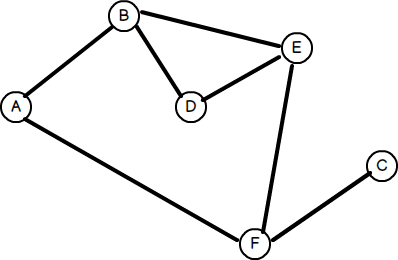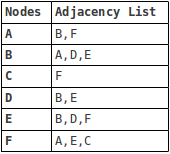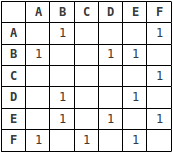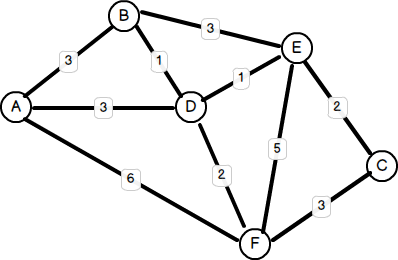PHP Master | Data Structures for PHP Devs: Graphs

Key Takeaways
- Graphs are mathematical constructs used to model relationships between key/value pairs and have numerous real-world applications such as network optimization, traffic routing, and social network analysis. They are made up of vertices (nodes) and edges (lines) that connect them, which can be directed or undirected, and weighted or unweighted.
- Graphs can be represented in two ways: as an adjacency matrix or an adjacency list. Adjacency lists are more space-efficient, especially for sparse graphs where most pairs of vertices are unconnected, while adjacency matrices facilitate quicker lookups.
- A common application of graph theory is finding the least number of hops (i.e., the shortest path) between any two nodes. This can be achieved using breadth-first search, which involves traversing the graph level by level from a designated root node. This process requires maintaining a queue of unvisited nodes.
- Dijkstra’s algorithm is widely used to find the shortest or most optimal path between any two nodes in a graph. This involves examining each edge between all possible pairs of vertices, starting from the source node, and maintaining an updated set of vertices with the shortest total distance until the target node is reached.
The Least Number of Hops
A common application of graph theory is finding the least number of hops between any two nodes. As with trees, graphs can be traversed in one of two ways: depth-first or breadth-first. We covered depth-first search in the previous article, so let’s take a look at breadth-first search. Consider the following graph:
1. Create a queue 2. Enqueue the root node and mark it as visited 3. While the queue is not empty do: 3a. dequeue the current node 3b. if the current node is the one we're looking for then stop 3c. else enqueue each unvisited adjacent node and mark as visited
Representing the Graph
There are generally two ways to represent a graph: either as an adjacency matrix or an adjacency list. The above graph represented as an adjacency list looks like this:

1. Create a queue 2. Enqueue the root node and mark it as visited 3. While the queue is not empty do: 3a. dequeue the current node 3b. if the current node is the one we're looking for then stop 3c. else enqueue each unvisited adjacent node and mark as visited
<span><span><?php
</span></span><span><span>$graph = array(
</span></span><span> <span>'A' => array('B', 'F'),
</span></span><span> <span>'B' => array('A', 'D', 'E'),
</span></span><span> <span>'C' => array('F'),
</span></span><span> <span>'D' => array('B', 'E'),
</span></span><span> <span>'E' => array('B', 'D', 'F'),
</span></span><span> <span>'F' => array('A', 'E', 'C'),
</span></span><span><span>);</span></span><span><span><?php
</span></span><span><span>class Graph
</span></span><span><span>{
</span></span><span> <span>protected $graph;
</span></span><span> <span>protected $visited = array();
</span></span><span>
</span><span> <span>public function __construct($graph) {
</span></span><span> <span>$this->graph = $graph;
</span></span><span> <span>}
</span></span><span>
</span><span> <span>// find least number of hops (edges) between 2 nodes
</span></span><span> <span>// (vertices)
</span></span><span> <span>public function breadthFirstSearch($origin, $destination) {
</span></span><span> <span>// mark all nodes as unvisited
</span></span><span> <span>foreach ($this->graph as $vertex => $adj) {
</span></span><span> <span>$this->visited[$vertex] = false;
</span></span><span> <span>}
</span></span><span>
</span><span> <span>// create an empty queue
</span></span><span> <span>$q = new SplQueue();
</span></span><span>
</span><span> <span>// enqueue the origin vertex and mark as visited
</span></span><span> <span>$q->enqueue($origin);
</span></span><span> <span>$this->visited[$origin] = true;
</span></span><span>
</span><span> <span>// this is used to track the path back from each node
</span></span><span> <span>$path = array();
</span></span><span> <span>$path[$origin] = new SplDoublyLinkedList();
</span></span><span> <span>$path[$origin]->setIteratorMode(
</span></span><span> <span>SplDoublyLinkedList<span>::</span>IT_MODE_FIFO|SplDoublyLinkedList<span>::</span>IT_MODE_KEEP
</span></span><span> <span>);
</span></span><span>
</span><span> <span>$path[$origin]->push($origin);
</span></span><span>
</span><span> <span>$found = false;
</span></span><span> <span>// while queue is not empty and destination not found
</span></span><span> <span>while (!$q->isEmpty() && $q->bottom() != $destination) {
</span></span><span> <span>$t = $q->dequeue();
</span></span><span>
</span><span> <span>if (!empty($this->graph[$t])) {
</span></span><span> <span>// for each adjacent neighbor
</span></span><span> <span>foreach ($this->graph[$t] as $vertex) {
</span></span><span> <span>if (!$this->visited[$vertex]) {
</span></span><span> <span>// if not yet visited, enqueue vertex and mark
</span></span><span> <span>// as visited
</span></span><span> <span>$q->enqueue($vertex);
</span></span><span> <span>$this->visited[$vertex] = true;
</span></span><span> <span>// add vertex to current path
</span></span><span> <span>$path[$vertex] = clone $path[$t];
</span></span><span> <span>$path[$vertex]->push($vertex);
</span></span><span> <span>}
</span></span><span> <span>}
</span></span><span> <span>}
</span></span><span> <span>}
</span></span><span>
</span><span> <span>if (isset($path[$destination])) {
</span></span><span> <span>echo "<span><span>$origin</span> to <span>$destination</span> in "</span>,
</span></span><span> <span>count($path[$destination]) - 1,
</span></span><span> <span>" hopsn";
</span></span><span> <span>$sep = '';
</span></span><span> <span>foreach ($path[$destination] as $vertex) {
</span></span><span> <span>echo $sep, $vertex;
</span></span><span> <span>$sep = '->';
</span></span><span> <span>}
</span></span><span> <span>echo "n";
</span></span><span> <span>}
</span></span><span> <span>else {
</span></span><span> <span>echo "No route from <span><span>$origin</span> to <span>$destinationn</span>"</span>;
</span></span><span> <span>}
</span></span><span> <span>}
</span></span><span><span>}</span></span>Finding the Shortest-Path
Another common problem is finding the most optimal path between any two nodes. Earlier I mentioned GoogleMap’s driving directions as an example of this. Other applications include planning travel itineraries, road traffic management, and train/bus scheduling. One of the most famous algorithms to address this problem was invented in 1959 by a 29 year-old computer scientist by the name of Edsger W. Dijkstra. In general terms, Dijkstra’s solution involves examining each edge between all possible pairs of vertices starting from the source node and maintaining an updated set of vertices with the shortest total distance until the target node is reached, or not reached, whichever the case may be. There are several ways to implement the solution, and indeed, over years following 1959 many enhancements – using MinHeaps, PriorityQueues, and Fibonacci Heaps – were made to Dijkstra’s original algorithm. Some improved performance, while others were designed to address shortcomings in Dijkstra’s solution since it only worked with positive weighted graphs (where the weights are positive values). Here’s an example of a (positive) weighted graph:
1. Create a queue 2. Enqueue the root node and mark it as visited 3. While the queue is not empty do: 3a. dequeue the current node 3b. if the current node is the one we're looking for then stop 3c. else enqueue each unvisited adjacent node and mark as visited
<span><span><?php
</span></span><span><span>$graph = array(
</span></span><span> <span>'A' => array('B', 'F'),
</span></span><span> <span>'B' => array('A', 'D', 'E'),
</span></span><span> <span>'C' => array('F'),
</span></span><span> <span>'D' => array('B', 'E'),
</span></span><span> <span>'E' => array('B', 'D', 'F'),
</span></span><span> <span>'F' => array('A', 'E', 'C'),
</span></span><span><span>);</span></span><span><span><?php
</span></span><span><span>class Graph
</span></span><span><span>{
</span></span><span> <span>protected $graph;
</span></span><span> <span>protected $visited = array();
</span></span><span>
</span><span> <span>public function __construct($graph) {
</span></span><span> <span>$this->graph = $graph;
</span></span><span> <span>}
</span></span><span>
</span><span> <span>// find least number of hops (edges) between 2 nodes
</span></span><span> <span>// (vertices)
</span></span><span> <span>public function breadthFirstSearch($origin, $destination) {
</span></span><span> <span>// mark all nodes as unvisited
</span></span><span> <span>foreach ($this->graph as $vertex => $adj) {
</span></span><span> <span>$this->visited[$vertex] = false;
</span></span><span> <span>}
</span></span><span>
</span><span> <span>// create an empty queue
</span></span><span> <span>$q = new SplQueue();
</span></span><span>
</span><span> <span>// enqueue the origin vertex and mark as visited
</span></span><span> <span>$q->enqueue($origin);
</span></span><span> <span>$this->visited[$origin] = true;
</span></span><span>
</span><span> <span>// this is used to track the path back from each node
</span></span><span> <span>$path = array();
</span></span><span> <span>$path[$origin] = new SplDoublyLinkedList();
</span></span><span> <span>$path[$origin]->setIteratorMode(
</span></span><span> <span>SplDoublyLinkedList<span>::</span>IT_MODE_FIFO|SplDoublyLinkedList<span>::</span>IT_MODE_KEEP
</span></span><span> <span>);
</span></span><span>
</span><span> <span>$path[$origin]->push($origin);
</span></span><span>
</span><span> <span>$found = false;
</span></span><span> <span>// while queue is not empty and destination not found
</span></span><span> <span>while (!$q->isEmpty() && $q->bottom() != $destination) {
</span></span><span> <span>$t = $q->dequeue();
</span></span><span>
</span><span> <span>if (!empty($this->graph[$t])) {
</span></span><span> <span>// for each adjacent neighbor
</span></span><span> <span>foreach ($this->graph[$t] as $vertex) {
</span></span><span> <span>if (!$this->visited[$vertex]) {
</span></span><span> <span>// if not yet visited, enqueue vertex and mark
</span></span><span> <span>// as visited
</span></span><span> <span>$q->enqueue($vertex);
</span></span><span> <span>$this->visited[$vertex] = true;
</span></span><span> <span>// add vertex to current path
</span></span><span> <span>$path[$vertex] = clone $path[$t];
</span></span><span> <span>$path[$vertex]->push($vertex);
</span></span><span> <span>}
</span></span><span> <span>}
</span></span><span> <span>}
</span></span><span> <span>}
</span></span><span>
</span><span> <span>if (isset($path[$destination])) {
</span></span><span> <span>echo "<span><span>$origin</span> to <span>$destination</span> in "</span>,
</span></span><span> <span>count($path[$destination]) - 1,
</span></span><span> <span>" hopsn";
</span></span><span> <span>$sep = '';
</span></span><span> <span>foreach ($path[$destination] as $vertex) {
</span></span><span> <span>echo $sep, $vertex;
</span></span><span> <span>$sep = '->';
</span></span><span> <span>}
</span></span><span> <span>echo "n";
</span></span><span> <span>}
</span></span><span> <span>else {
</span></span><span> <span>echo "No route from <span><span>$origin</span> to <span>$destinationn</span>"</span>;
</span></span><span> <span>}
</span></span><span> <span>}
</span></span><span><span>}</span></span>Summary
In this article I’ve introduced the basics of graph theory, two ways of representing graphs, and two fundamental problems in the application of graph theory. I’ve shown you how a breadth-first search is used to find the least number of hops between any two nodes, and how Dijkstra’s solution is used to find the shortest-path between any two nodes. Image via FotoliaFrequently Asked Questions (FAQs) about Graphs in Data Structures
What is the difference between a graph and a tree in data structures?
A graph and a tree are both non-linear data structures, but they have some key differences. A tree is a type of graph, but not all graphs are trees. A tree is a connected graph without any cycles. It has a hierarchical structure with a root node and child nodes. Each node in a tree has a unique path from the root. On the other hand, a graph can have cycles and its structure is more complex. It can be connected or disconnected and nodes can have multiple paths between them.
How are graphs represented in data structures?
Graphs in data structures can be represented in two ways: adjacency matrix and adjacency list. An adjacency matrix is a 2D array of size V x V where V is the number of vertices in the graph. If there is an edge between vertices i and j, then the cell at the intersection of row i and column j will be 1, otherwise 0. An adjacency list is an array of linked lists. The index of the array represents a vertex and each element in its linked list represents the other vertices that form an edge with the vertex.
What are the types of graphs in data structures?
There are several types of graphs in data structures. A simple graph is a graph with no loops and no more than one edge between any two vertices. A multigraph can have multiple edges between vertices. A complete graph is a simple graph where every pair of vertices is connected by an edge. A weighted graph assigns a weight to each edge. A directed graph (or digraph) has edges with a direction. The edges point from one vertex to another.
What are the applications of graphs in computer science?
Graphs are used in numerous applications in computer science. They are used in social networks to represent connections between people. They are used in web crawling to visit web pages and build a search index. They are used in network routing algorithms to find the best path between two nodes. They are used in biology to model and analyze biological networks. They are also used in computer graphics and physics simulations.
What are the graph traversal algorithms?
There are two main graph traversal algorithms: Depth-First Search (DFS) and Breadth-First Search (BFS). DFS explores as far as possible along each branch before backtracking. It uses a stack data structure. BFS explores all the vertices at the present depth before going to the next level. It uses a queue data structure.
How to implement a graph in Java?
In Java, a graph can be implemented using a HashMap to store the adjacency list. Each key in the HashMap is a vertex and its value is a LinkedList containing the vertices that it is connected to.
What is a bipartite graph?
A bipartite graph is a graph whose vertices can be divided into two disjoint sets such that every edge connects a vertex in one set to a vertex in the other set. No edge connects vertices within the same set.
What is a subgraph?
A subgraph is a graph that is a part of another graph. It has some (or all) vertices of the original graph and some (or all) edges of the original graph.
What is a cycle in a graph?
A cycle in a graph is a path that starts and ends at the same vertex and has at least one edge.
What is a path in a graph?
A path in a graph is a sequence of vertices where each pair of consecutive vertices is connected by an edge.
The above is the detailed content of PHP Master | Data Structures for PHP Devs: Graphs. For more information, please follow other related articles on the PHP Chinese website!

Hot AI Tools

Undresser.AI Undress
AI-powered app for creating realistic nude photos

AI Clothes Remover
Online AI tool for removing clothes from photos.

Undress AI Tool
Undress images for free

Clothoff.io
AI clothes remover

Video Face Swap
Swap faces in any video effortlessly with our completely free AI face swap tool!

Hot Article

Hot Tools

Notepad++7.3.1
Easy-to-use and free code editor

SublimeText3 Chinese version
Chinese version, very easy to use

Zend Studio 13.0.1
Powerful PHP integrated development environment

Dreamweaver CS6
Visual web development tools

SublimeText3 Mac version
God-level code editing software (SublimeText3)

Hot Topics
 1662
1662
 14
14
 1419
1419
 52
52
 1311
1311
 25
25
 1261
1261
 29
29
 1234
1234
 24
24
 Explain different error types in PHP (Notice, Warning, Fatal Error, Parse Error).
Apr 08, 2025 am 12:03 AM
Explain different error types in PHP (Notice, Warning, Fatal Error, Parse Error).
Apr 08, 2025 am 12:03 AM
There are four main error types in PHP: 1.Notice: the slightest, will not interrupt the program, such as accessing undefined variables; 2. Warning: serious than Notice, will not terminate the program, such as containing no files; 3. FatalError: the most serious, will terminate the program, such as calling no function; 4. ParseError: syntax error, will prevent the program from being executed, such as forgetting to add the end tag.
 PHP and Python: Comparing Two Popular Programming Languages
Apr 14, 2025 am 12:13 AM
PHP and Python: Comparing Two Popular Programming Languages
Apr 14, 2025 am 12:13 AM
PHP and Python each have their own advantages, and choose according to project requirements. 1.PHP is suitable for web development, especially for rapid development and maintenance of websites. 2. Python is suitable for data science, machine learning and artificial intelligence, with concise syntax and suitable for beginners.
 Explain secure password hashing in PHP (e.g., password_hash, password_verify). Why not use MD5 or SHA1?
Apr 17, 2025 am 12:06 AM
Explain secure password hashing in PHP (e.g., password_hash, password_verify). Why not use MD5 or SHA1?
Apr 17, 2025 am 12:06 AM
In PHP, password_hash and password_verify functions should be used to implement secure password hashing, and MD5 or SHA1 should not be used. 1) password_hash generates a hash containing salt values to enhance security. 2) Password_verify verify password and ensure security by comparing hash values. 3) MD5 and SHA1 are vulnerable and lack salt values, and are not suitable for modern password security.
 PHP in Action: Real-World Examples and Applications
Apr 14, 2025 am 12:19 AM
PHP in Action: Real-World Examples and Applications
Apr 14, 2025 am 12:19 AM
PHP is widely used in e-commerce, content management systems and API development. 1) E-commerce: used for shopping cart function and payment processing. 2) Content management system: used for dynamic content generation and user management. 3) API development: used for RESTful API development and API security. Through performance optimization and best practices, the efficiency and maintainability of PHP applications are improved.
 What are HTTP request methods (GET, POST, PUT, DELETE, etc.) and when should each be used?
Apr 09, 2025 am 12:09 AM
What are HTTP request methods (GET, POST, PUT, DELETE, etc.) and when should each be used?
Apr 09, 2025 am 12:09 AM
HTTP request methods include GET, POST, PUT and DELETE, which are used to obtain, submit, update and delete resources respectively. 1. The GET method is used to obtain resources and is suitable for read operations. 2. The POST method is used to submit data and is often used to create new resources. 3. The PUT method is used to update resources and is suitable for complete updates. 4. The DELETE method is used to delete resources and is suitable for deletion operations.
 PHP: A Key Language for Web Development
Apr 13, 2025 am 12:08 AM
PHP: A Key Language for Web Development
Apr 13, 2025 am 12:08 AM
PHP is a scripting language widely used on the server side, especially suitable for web development. 1.PHP can embed HTML, process HTTP requests and responses, and supports a variety of databases. 2.PHP is used to generate dynamic web content, process form data, access databases, etc., with strong community support and open source resources. 3. PHP is an interpreted language, and the execution process includes lexical analysis, grammatical analysis, compilation and execution. 4.PHP can be combined with MySQL for advanced applications such as user registration systems. 5. When debugging PHP, you can use functions such as error_reporting() and var_dump(). 6. Optimize PHP code to use caching mechanisms, optimize database queries and use built-in functions. 7
 How does PHP handle file uploads securely?
Apr 10, 2025 am 09:37 AM
How does PHP handle file uploads securely?
Apr 10, 2025 am 09:37 AM
PHP handles file uploads through the $\_FILES variable. The methods to ensure security include: 1. Check upload errors, 2. Verify file type and size, 3. Prevent file overwriting, 4. Move files to a permanent storage location.
 Explain the difference between self::, parent::, and static:: in PHP OOP.
Apr 09, 2025 am 12:04 AM
Explain the difference between self::, parent::, and static:: in PHP OOP.
Apr 09, 2025 am 12:04 AM
In PHPOOP, self:: refers to the current class, parent:: refers to the parent class, static:: is used for late static binding. 1.self:: is used for static method and constant calls, but does not support late static binding. 2.parent:: is used for subclasses to call parent class methods, and private methods cannot be accessed. 3.static:: supports late static binding, suitable for inheritance and polymorphism, but may affect the readability of the code.




